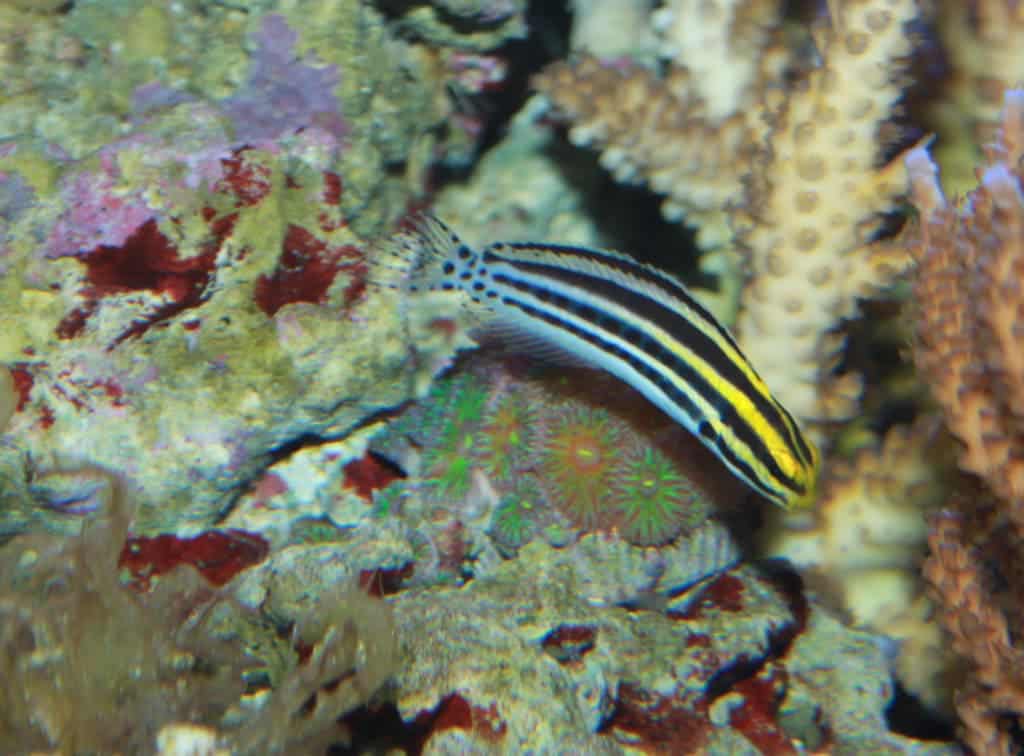Unlike other venomous fish, a fang blenny (tribe Meiacanthus) bite won’t kill you or have you writhe in agony — it will probably make you dizzy and might even mellow you out. Their venom could form the basis of a new class of powerful painkillers.

Image credits Brian Gratwicke.
It’s a tough life being a 1.5-to-3 inch (four-seven centimeter) fish in a big ocean/aquarium, as the fang blennies have found over the ages. So they armed themselves with a set of very big fangs (relatively to their body size) — two canine teeth that jut out menacingly from their lower jaw. And just to make double sure everyone got the message, they also filled these fangs with venom.
But it’s not your typical fish venom, as an international team of researchers found. Its chemical make-up most likely disorients or otherwise impairs predators’ ability to give chase by lacing them in opioids.
The good venom
Getting hold of the venom wasn’t easy. Fang blennies only inject a tiny drop of venom with each bite, much too little for a workable sample. The team worked around this issue by taking the fish out of their tanks and dangling cotton swabs in front of them until they bit to get the venom. The fish were then returned to the tanks and the swabs were suspended in a solution to draw out the venom.
Protein analysis performed on it found three components go into the mix — a neuropeptide also seen in cone snail venom, a lipase similar to the one used by certain species of scorpions, and an opioid peptide. When injected into lab mice, this venom didn’t seem to cause the animals any pain, which was surprising to say the least.
“For the fang blenny venom to be painless in mice was quite a surprise,” says Bryan Fry from the University of Queensland, co-author of the paper.
“Fish with venomous dorsal spines produce immediate and blinding pain. The most pain I’ve ever been in other than the time I broke my back was from a stingray envenomation. ‘Sting’ray sounds so benign. They don’t sting. They are pure hell.”
Stepping away from the traditional take on chemical defense, fang blennies turned to venom whose neuropeptide and opioid components seem to cause a sudden drop in blood pressure, leaving a would-be predator dazed and unable to pursue the fish. It can also be used in case the benny was already caught and eaten. One bite of the predator’s gums or tongue and the venom will make it shake, quiver, and open its jaws and gills really wide — giving the blenny a clean escape.
“The fish injects other fish with opioid peptides that act like heroin or morphine, inhibiting pain rather than causing it,” Fry explains.
“While the feeling of pain is not produced, opioids can produce sensations of extremely unpleasant nausea and dizziness. The venom causes the bitten fish to become slower in movement and dizzy by acting on their opioid receptors.”
The team can’t be sure-sure this painlessness holds true in the wild, however, since the venom has only been tested on mice — who are notorious for their limited vocabulary. There’s also the possibility that this chemical cocktail could interact differently with mammals than it does with fish.
Still, even a non-lethal effect is enough to allow blennies to escape their predators. And the venom’s effect on mammals suggests that it might be used to develop a very powerful class of painkillers.
“To put [the venom’s effects] into human terms, opioid peptides would be the last thing an elite Olympic swimmer would use as performance-enhancing substances. They would be more likely to drown than win gold.”
Bite first, venom later

Image credits Anthony Romilio.
Another surprising find was that the ‘fang’ part of fanged blennies likely evolved before the venom. It’s a very unusual evolutionary line. Most venomous animals, take snakes for example, developed venomous glands first, which then required a delivery system, creating the evolutionary need for fangs. But these tiny fish seem to have grown the canines first and the venom then evolved to make them even more useful.
“These unassuming little fish have a really quite advanced venom system, and that venom system has a major impact on fishes and other animals in its community,” says study co-author Nicholas Casewell of the Liverpool School of Tropical Medicine.
Some other species have found a way to cash in on the venom without going to the trouble of actually evolving to incorporate it — by mimicking the color patterns of venomous fang blenny species, nonvenomous blennies and other small fish can ruse predators into backing down.
“Predatory fish will not eat those fishes because they think they are venomous and going to cause them harm, but this protection provided also allows some of these mimics to get very close to unsuspecting fish to feed on them, by picking on their scales as a micropredator,” Casewell adds.
“All of this mimicry, all of these interactions at the community level, ultimately are stimulated by the venom system that some of these fish have.”
Fry said the fanged blenny was an “excellent example” of why nature and unique habitats must be protected, particularly the Great Barrier Reef.
“If we lose the Great Barrier Reef, we will lose animals like the fang blenny and its unique venom that could be the source of the next blockbuster painkilling drug.”
The team started their study with “no grand hypothesis, just basic wonderment” says Fry, but given the results, they plan to continue the study by analyzing the composition of venoms from different blenny species.
The paper “The Evolution of Fangs, Venom, and Mimicry Systems in Blenny Fishes” has been published in the journal Current Biology.






